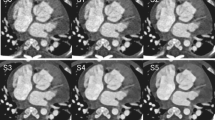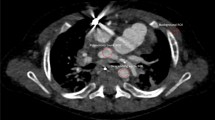Abstract
To assess a two-phase contrast injection protocol for contrast enhancement during cardiac computed tomography (CT) in children with congenital heart disease. Forty-three children (20 boys, 23 girls) of median age 13 months (range 3 days—8.3 years) and weighing ≤ 20 kg who underwent cardiac CT using a two-phase contrast injection protocol at our institution were retrospectively identified. High-pitch spiral third-generation dual-source cardiac CT (tube voltage 70 kV) was performed with a fixed delay of 60 s after contrast injection in the order of 10 mgI/kg/s (30 s), 15 mgI/kg/s (20 s), and a saline chaser (10 s). Attenuation in the inferior vena cava (IVC), superior vena cava (SVC), right atrium (RA), right ventricle (RV), pulmonary artery (PA), left atrium (LA), left ventricle (LV), and descending aorta (AO) was compared using the Steel–Dwass and Fisher’s exact tests. The median (interquartile range) attenuation in the IVC, SVC, RA, RV, PA, LA, LV, and AO was 285 (264–347) Hounsfield units (HU), 416 (370–445) HU, 368 (320–388) HU, 373 (322–417) HU, 397 (330–432) HU, 425 (373–469) HU, 435 (385–468) HU, and 437 (392–491) HU, respectively (p < 0.05, IVC vs. the other anatomic sites). There was no significant difference in diagnostic success rate for attenuation > 250 HU between the IVC (41 children, 95.3%) and the other sites (43 children, 100%). A two-phase contrast injection protocol is useful for effective contrast enhancement in pediatric cardiac CT.



Similar content being viewed by others
References
Roest AA, de Roos A (2011) Imaging of patients with congenital heart disease. Nat Rev Cardiol 9:101–115
Mertens L, Friedberg MK (2009) The gold standard for noninvasive imaging in congenital heart disease: echocardiography. Curr Opin Cardiol 24:119–124
Roguin A, Schwitter J, Vahlhaus C, Lombardi M, Brugada J, Vardas P, Auricchio A, Priori S, Sommer T (2008) Magnetic resonance imaging in individuals with cardiovascular implantable electronic devices. Europace 10:336–346
Hundley WG, Bluemke DA, Finn JP, Flamm SD, Fogel MA, Friedrich MG, Ho VB, Jerosch-Herold M, Kramer CM, Manning WJ, Patel M, Pohost GM, Stillman AE, White RD, Woodard PK (2010) ACCF/ACR/AHA/NASCI/SCMR 2010 expert consensus document on cardiovascular magnetic resonance: a report of the American College of Cardiology Foundation Task Force on Expert Consensus Documents. J Am Coll Cardiol 55:2614–2662
Nakagawa M, Hara M, Sakurai K, Ohashi K, Asano M, Shibamoto Y (2011) Usefulness of electrocardiography-gated dual-source computed tomography for evaluating morphological features of the ventricles in children with complex congenital heart defects. Jpn J Radiol 29:540–546
Han BK, Rigsby CK, Leipsic J, Bardo D, Abbara S, Ghoshhajra B, Lesser JR, Raman SV, Crean AM, Nicol ED, Siegel MJ, Hlavacek A (2015) Computed tomography imaging in patients with congenital heart disease, part 2: technical recommendations. An expert consensus document of the Society of Cardiovascular Computed Tomography (SCCT): endorsed by the Society of Pediatric Radiology (SPR) and the North American Society of Cardiac Imaging (NASCI). J Cardiovasc Comput Tomogr 9:493–513
Nakagawa M, Ozawa Y, Sakurai K, Shimohira M, Ohashi K, Asano M, Yamaguchi S, Shibamoto Y (2015) Image quality at low tube voltage (70 kV) and sinogram-affirmed iterative reconstruction for computed tomography in infants with congenital heart disease. Pediatr Radiol 45:1472–1479
Han BK, Lesser JR (2013) CT imaging in congenital heart disease: an approach to imaging and interpreting complex lesions after surgical intervention for tetralogy of Fallot, transposition of the great arteries, and single ventricle heart disease. J Cardiovasc Comput Tomogr 7:290–383
Jelnin V, Co J, Muneer B, Swaminathan B, Toska S, Ruiz CE (2016) Three dimensional CT angiography for patients with congenital heart disease: Scanning protocol for pediatric patients. Catheter Cardiovasc Interv 67:120–126
Valentin J (ed) (2007) The 2007 Recommendations of the International Commission on Radiological Protection. ICRP publication 103. Ann ICRP 37:1–332. http://www.icrp.org/docs/ICRP_Publication_103-Annals_of_the_ICRP_37(2-4)-Free_extract.pdf
Lee KH, Yoon CS, Choe KO, Kim MJ, Lee HM, Yoon HK, Kim B (2001) Use of imaging for assessing anatomical relationships of tracheobronchial anomalies associated with left pulmonary artery sling. Pediatr Radiol 31:269–278
Nie P, Li H, Duan Y, Wang X, Ji X, Cheng Z, Wang A, Chen J (2014) Impact of sinogram affirmed iterative reconstruction (SAFIRE) algorithm on image quality with 70 kVp-tube-voltage dual-source CT angiography in children with congenital heart disease. PLoS ONE 9:e91123. https://doi.org/10.1371/journal.pone.0091123
Scholtz JE, Wichmann JL, Hüsers K, Beeres M, Nour-Eldin NE, Frellesen C, Vogl TJ, Lehnert T (2015) Automated tube voltage adaptation in combination with advanced modeled iterative reconstruction in thoracoabdominal third-generation 192-slice dual-source computed tomography: effects on image quality and radiation dose. Acad Radiol 22:1081–1087
Han JK, Choi BI, Kim AY, Kim SJ (2001) Contrast media in abdominal computed tomography: optimization of delivery methods. Korean J Radiol 2:28–36
Nakagawa M, Hara M, Shibamoto Y (2009) A prospective study to evaluate the depictability of the hepatic veins on abdominal contrast-enhanced CT in small children. Pediatr Radiol 39:933–937
Campbell RM, Douglas PS, Eidem BW et al (2014) ACC/AAP/AHA/ASE/HRS/SCAI/SCCT/SCMR/SOPE 2014 appropriate use criteria for initial transthoracic echocardiography in outpatient pediatric cardiology: a report of the American College of Cardiology Appropriate Use Criteria Task Force., American Academy of Pediatrics, American Heart Association, American Society of Echocardiography, Heart Rhythm Society, Society for Cardiovascular Angiography and Interventions, Society of Cardiovascular Computed Tomography, Society for Cardiovascular Magnetic Resonance, and Society of Pediatric Echocardiography. J Am Coll Cardiol 64:2039–2060
Douglas PS, Garcia MJ, Haines DE et al (2011) ACCF/ASE/AHA/ASNC/HFSA/HRS/SCAI/SCCM/SCCT/SCMR 2011 appropriate use criteria for echocardiography. A Report of the American College of Cardiology Foundation Appropriate Use Criteria Task Force, American Society of Echocardiography, American Heart Association, American Society of Nuclear Cardiology, Heart Failure Society of America, Heart Rhythm Society, Society for Cardiovascular Angiography and Interventions, Society of Critical Care Medicine, Society of Cardiovascular Computed Tomography, and Society for Cardiovascular Magnetic Resonance Endorsed by the American College of Chest Physicians. J Am Coll Cardiol 57:1126–1166
Hamaoka T, Ishikawa S, Itokawa T et al. (2009) Guidelines for the clinical examinations for decision making of diagnosis, pathophysiology, and therapy in congenital heart disease (JCS 2009). http://www.j-circ.or.jp/guideline/pdf/JCS2010_hamaoka_h.pdf. Accessed 18 Oct 2017 (in Japanese)
Ogawa H, Ono M, Kosaka S et al. (2016) The Japanese registry of all cardiac and vascular diseases (JROAD). http://www.j-circ.or.jp/jittai_chosa/jittai_chosa2015web.pdf. Accessed 18 Oct 2017 (in Japanese)
ICRP (2000) Managing patient dose in computed tomography. Ann ICRP 30(4):7–45
Verdun FR, Gutierrez D, Vader JP et al (2008) CT radiation dose in children: a survey to establish age-based diagnostic reference levels in Switzerland. Eur Radiol 18:1980–1986
Vassileva J, Rehani MM, Applegate K et al (2013) IAEA survey of paediatric computed tomography practice in 40 countries in Asia, Europe, Latin America and Africa: procedures and protocols. Eur Radiol 23:623–631
Takei Y, Miyazaki O, Matsubara K et al (2016) Nationwide survey of radiation exposure during pediatric computed tomography examinations and proposal of age-based diagnostic reference levels for Japan. Pediatr Radiol 46:280–285
Japan Network for Research and Information on Medical Exposures (J-RIME) (2015) Diagnostic reference levels based on latest surveys in Japan-Japan DRLs 2015. http://www.radher.jp/JRIME/report/DRLhoukokusyoEng.pdf. Accessed 18 Oct 2017
Author information
Authors and Affiliations
Corresponding author
Ethics declarations
Conflict of interest
Toshihide Itoh is an employee of Siemens Healthcare Japan. However, all the other authors had access to the study data at all stages without limitation, and the data were not manipulated in any way that might have created a conflict of interest. All pediatric cardiology policies on sharing data and materials were adhered to. The other authors declare no conflicts of interest.
Informed Consent
The need for formal informed consent was waived in view of the retrospective nature of the research.
Research Involving Human Participants and/or Animals
The study was conducted in accordance with the ethical standards at our hospital and the Declaration of Helsinki, and was approved by the local ethics committee. All patient information was collected and protected in compliance with the guidelines of our institutional review board.
Rights and permissions
About this article
Cite this article
Fukuyama, N., Kurata, A., Kawaguchi, N. et al. Two-Phase Contrast Injection Protocol for Pediatric Cardiac Computed Tomography in Children with Congenital Heart Disease. Pediatr Cardiol 39, 518–525 (2018). https://doi.org/10.1007/s00246-017-1782-7
Received:
Accepted:
Published:
Issue Date:
DOI: https://doi.org/10.1007/s00246-017-1782-7




